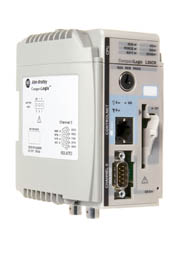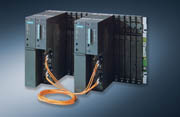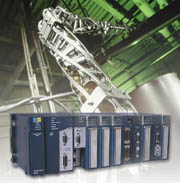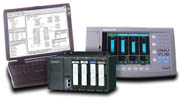
An up-to-date process control system can gather all this information for you automatically and put it in the form that the FDA requires. But if your plant operators are still using a clipboard to record temperature, pressure, flow and level measurements manually, and making changes to process setpoints by hand, it's time to think about upgrading and retrofitting. Whether you brew beer, bake cookies or process fruit for shipment, getting data electronically from your process will satisfy the FDA and allow you to control your batches more precisely, producing consistent product. This means less waste, better use of assets, energy savings, flexibility in changeovers and decreased manufacturing costs.
Dan Throne, food and packaging business manager at Bosch Rexroth Electric Drives and Controls, notes that with the economy's marginal upswing over the last few years, many food producers have chosen to retrofit their existing machines to provide either higher production or automated changeovers. While this addresses the need for flexible case configurations for club-pack stores like Wal-Mart and Sam's Club, most producers have been driven by a need to increase flexibility and reduce manufacturing costs.
Still islands of automation?
Automation-whether retrofit or new-has to be considered within an overall communication scheme, otherwise there will be isolated groups of equipment. While many manufacturing plants have solved the "islands of automation" syndrome that stems from a lack of communication, many food and beverage companies still have the problem.
"We needed a platform that would allow us to expand throughput capability; implement a new juice recovery system while retiring an antiquated filtration system; and simplify and control processing options," said ENZAFOODS' Factory Manager Clayton McIntyre. He wanted to use the existing variable speed drives (VSDs) rather than invest in replacements. To get this project under way, system integrator StreatAutomation used Rockwell Automation's DeviceNet interface to make the existing drives an integral part of the new control and SCADA installation. Rockwell's Flex I/O was used, communicating across an existing DeviceNet network, which was expanded to include several VSDs that had previously been hardwired.
Three DeviceNets were installed, each operating a core process. The first network ran the raw product processing, main product flow manifold banks and product storage tanks. The second ran the pasteurizing and ultra filtration processes, while the third ran CIP, bulk batching and cleaning controls.
DeviceNet requires fewer cables, eliminating the need for long cable runs to the plant's motors and field devices. Localized motor control centers and control boards provide a convenient termination point for all local motors, valves and controls. According to StreatAutomation's Project Manager Mark Heath, "Problems are easier to resolve when wired feedback is close to the field device and the location of the control boards relevant to the local processes aid in fault finding."
Using DeviceNet reduced installation costs by 30% and increased the safety of the operation. The Flex I/O allowed further cost reductions in the manufacture of control boxes because there was no need to supply the traditional wiring from the PLC terminals to field terminals. As a result, the expansion capability on some control boards increased by more than 30%.
Start with sensors
Most sensors are analog devices, and their associated transmitters make their signals suitable to controllers-possibly single or multiloop controllers or PLCs. Digital transmitters today cannot only relay a temperature or pressure variable, but they can also provide diagnostic data. But according to Maria Piazza, automation solutions commercial director, GE Fanuc Automation, most small- to medium-sized food manufacturers in the US are still using 4-20 mA analog transmitters.
While dumb sensors can't predict their own failure or report other difficulties, some controllers can predict sensor problems based on abnormal sensor signals. According to Honeywell system integrator Channel Leader Bill Stevens, "We've provided diagnostics on direct sensor inputs [on the HC 900 hybrid controller], that tell the user before, for example, the thermocouple goes bad that it is approaching bad conditions. This allows the user to change the thermocouple or switch in another one automatically before data is lost or a batch ruined-as well as satisfying FDA requirements for logging temperature data during a sterilization process."

Smart I/O
If you decide to use smart sensors/ transmitters, then it makes sense to choose an intelligent fieldbus network and smart I/O systems, says Allen Cuthrell, a consultant who worked on the Pepperidge Farm project that won Food Engineering's 2004 Plant of the Year award. According to Cuthrell, a lot of the construction cost of any project is driven by field panel terminations, and using a fieldbus system like DeviceNet can save big money on wiring costs.If users can keep their old I/O structures and expand their new I/O systems, they'll also find savings in both wiring and getting useful data.
What's important, according to Opto 22 Application Engineer James Wilcox, is using smart I/O to get data from new sources as well as existing sources and then to process that data. For example, an engineer could add a vibration sensor to monitor a refrigerant compressor. While the compressor may already have thermal or pressure sensors, the I/O system can process the vibration sensor's output and send it over the ethernet to a datalogger or a database that keeps track of devices and predicts when the bearings in the compressor will fail. Before failure, that database can generate predictive maintenance reports that the compressor is about to fail. What is most important, says Wilcox, is providing as much information as possible to let the user make a smarter decision.
With a smart I/O system, the ability to add modules in a step-wise fashion during design can improve cash flow on a project. "Project cash flow is significantly eased with the Foxboro A2 DCS since the entire remote I/O installation can be performed with the purchase of only 20% (in terms of cost) of the I/O system," says Stephen Arnold, an engineer with Neal Systems, an Invensys system integrator. "Customers are able to postpone purchasing the rest of the modules until shortly before installation is completed. This is because the I/O system is made up of a rack, inexpensive termination assemblies and I/O modules. The system is wired completely with just the rack and termination assemblies-something that PLCs don't accommodate."
A sensible way to upgrade may be to leave I/O in place, provided that new controllers are backward compatible with existing I/O. Brian Owens, segment manager-industrial process and services, Schenider Electric, observes that customers with 15-to 20-year-old equipment who want the processing power from a new CPU don't have to spend a lot of money to replace an entire system. Instead, they can leave their I/O in place and move to a new controller without having to replace or rewire I/O and recheck it before starting the machine. When it comes time to update I/O, they can do it as they see fit and within their budget. The more powerful system will allow them to expand their operation, gather data, communicate more efficiently, monitor remotely, meet 21 CFR requirements or use web tools.
Werner Dettelbacher, head of electronics technology at Dannon in Ochsenfurt, Germany, a facility that packages up to three million containers of chocolate desserts and yogurt every day, notes another important reason to choose a fieldbus like Profibus-namely, to ensure compatibility between the different automation systems. "The decision was made for a fieldbus independent bus module from Wago," says Dettelbacher. "It was the best technical and economic solution." The Wago I/O system offered the possibility to connect sensors and actuators to a decentralized automation solution, independent from the selected fieldbus. There are fieldbus couplers to connect to all important fieldbus systems.
Connecting the control components without a fieldbus interface is also possible with an RS232 or RS485 interface module. According to Dettelbacher, different sensors and actuators can be directly connected to the I/O modules, allowing additional terminal strips or other equipment to be connected with minimal wiring expense. The fieldbus interface resulted in a considerable reduction of installation costs, mainly for material and time. The Dannon plant processes 1,000 I/O signals per product line and 600 I/O signals per packaging line. With ten product lines and nine packaging lines, there are more than 15,000 I/O. Dannon estimated that it saved one-third the cost of what parallel wiring would have cost.

Update aging controllers
How do you upgrade your controls for 21 CFR compliance? It depends on what controls and interfaces you already have in place, and which, if any, may already be 21 CFR compliant. An Invensys white paper, "21 CFR Part 11 Remediation Strategies," suggests four options: First, replace the existing control system; second, add a compliant data acquisition system to the existing control system; third, add a compliant data logging unit to the existing control system; or fourth, add a compliant "front end" to the current noncompliant system.
If you have aging PLCs that still have serial connections, one of the better reasons to upgrade, according to Cuthrell, is faster communication. For example, the AB PLC-2 didn't really afford faster communication, and the PLC-5 supported data highway and ethernet with a plug-in card. Today, ControlLogix supports multiple processors, is much cheaper, more powerful and expandable, and has better programming tools and ethernet communications.
Another not-so-obvious reason to upgrade, according to Todd Stauffer, product marketing manager for PCS 7, Siemens Energy and Automation, is that a 20-year-old PLC just wasn't designed with the security measures that are standard procedure in modern PLC design. Stauffer contends that even with older, proprietary PLCs hooked into larger plant-wide systems via serial links, the possibility for hackers to get to that PLC is real-and easier than modern ethernet TCP/IP connected PLCs, whose vendors have taken special efforts to hide and protect the controller from hackers.
Ethernet is the key to better communications. Says Owens, "Ethernet is so pervasive on the factory floor despite what many nay-sayers said five or six years ago. It gives manufacturers the ability to use more open systems, and for us the ability not to have to put off doing a project for a year because we have to pull new cable, run conduit, build some proprietary network, or pay a large price for a proprietary network interface for a PC or database system. The other advantage is that manufacturers have either an onsite or on-contract IT group that allows them to manage the network easily without paying the extra cost of having a control specialist."
Consider ethernet as the conduit from manufacturing to management. Cerestar, producer of high-fructose corn syrup located in Dimmitt, TX, needed to update its aging GE Series 5 and 6 PLCs and implement an e-manufacturing solution. "With all the power the upgraded PLCs offer in terms of speed and I/O communications, it was only natural for us to take that power and apply it to a broader control and networking solution, says Kennon Howell, Cerestar maintenance and engineering manager. "We also knew an ethernet backbone would give us the speed and reliability we sought, as well as the option to expand into higher-level systems in the future."
Currently monitoring approximately 6,100 I/O points, the Windows-based CIMPLICITY software extends the functionality of the new Series 90-70 PLCs and Genuis I/O blocks by providing a graphical interface with real-time monitoring and control capabilities, including database tools that log information and compile reports for all of Cerestar's process equipment, such as boilers, furnaces, storage tanks and air compressors. The software's manufacturing control features also allow operators to make equipment adjustments like starting and stopping motors and conveyors and opening and closing valves. And, because of the software's object-oriented approach, Cerestar can create screens to handle any number of operating parameters, ranging in complexity from simple status screens and alarm reports to more complex screens displaying diagnostics and analysis of, for example, starch as it progresses through the conversion process.
As with other upgrades making use of smart I/O, self-diagnostics down to the sensor level and a CPU on each I/O module, wiring costs are reduced, and maintenance gets reports diagnosing open or short circuits, under or over range and wiring errors, reducing the maintenance effort. According to Cerestar's Electrical Maintenance Supervisor Bill McMillon, "Our programmers were able to handle the system-the PLC, I/O blocks, and software-after only three days of training."
DCS, PLC or hybrid?
Automation designers have so many options in hardware selection. Whether you decide to purchase a DCS, PLC, I/O-based SCADA, or hybrid solution, most automation vendors offer ethernet-based products because their customers now demand open systems. But this decision, according to Gary Silverman, senior manufacturing consultant for Emerson's Life Sciences and Food and Beverage Group, is rarely made by just plant controls engineers. And it shouldn't be. Manufacturers should have their IT, finance, quality, and R&D groups involved as well because, along with other concerns, time-to-market and process improvements are so critical.
PLCs have taken off in two areas, according to Schneider's Owens. One is the explosive growth of very small or "nano" PLCs, which with their low (under $200) prices allows machine designers to use them almost anywhere they're needed. In the past, designers would have used programmable timers and relays because PLCs were too expensive. Second, food and beverage users are looking for visualization aspects of the PLC, for example, using Java with built-in web servers to allow users to get a view of the process, thus eliminating the need for a proprietary SCADA package. If the data needs to go to a supervisory system or a database using SQL or Oracle, Schneider uses the publish-and-subscribe technique. The ethernet makes it easy to move the data to systems that generate reports that meet regulatory standards.
Hybrid controllers
There are two basic approaches to hybrid controllers. The PLC vendors saw a need to add continuous or analog functionality to their controllers, and for a while they added plug-in boards to their PLCs that could handle analog functionality. Similarly, the DCS vendors saw a need to add discrete functions to their DCSs, and often integrated PLCs into their overall control schemes.
These controllers are a good choice for manufacturers, system integrators and machine builders where control might involve discrete functions, PID control and motion control. If plans involve packaging and other processes requiring motion, then it's a good idea to make sure that the controller supports motion.
From a hardware standpoint, there are plenty of choices available to update your I/O, interfaces and controllers. And as you've seen, using a digital fieldbus can save in wiring costs. Whether you update or build new, selection of hardware is an important issue, but the selection of software that runs on the hardware is even more crucial-in fact, it defines the "personality" of your plant. Focusing on the needs of the business will help define the controls and interfaces. As Emerson's Silverman points out, "The challenge is running your plant, not your equipment."
For more information:
Dan Throne, Bosch Rexroth,
847-645-3749
Mark Heath, StreatAutomation,
61 2 8206 6060 or
908-253-3588
Maria Piazza, GE Fanuc Automation,
800-433-2682
Bill Stevens, Honeywell,
215-641-3000
Allen Cuthrell,
864-363-0994
James Wilcox, Opto 22,
800-321-6786
Stephen Arnold, Neal Systems,
215-968-7577
Brian Owens, Schneider Electric,
919-855-1141
Todd Stauffer, Siemens Energy and Automation,
215-646-7400
Gary Silverman, Emerson Process,
720-497-1518


